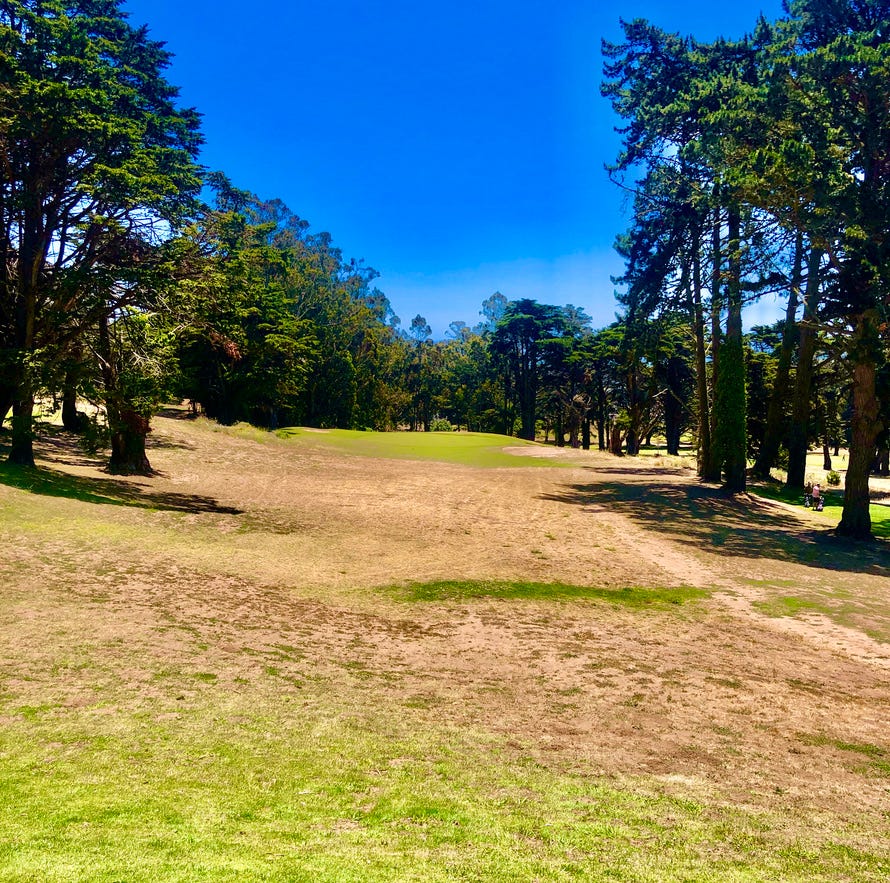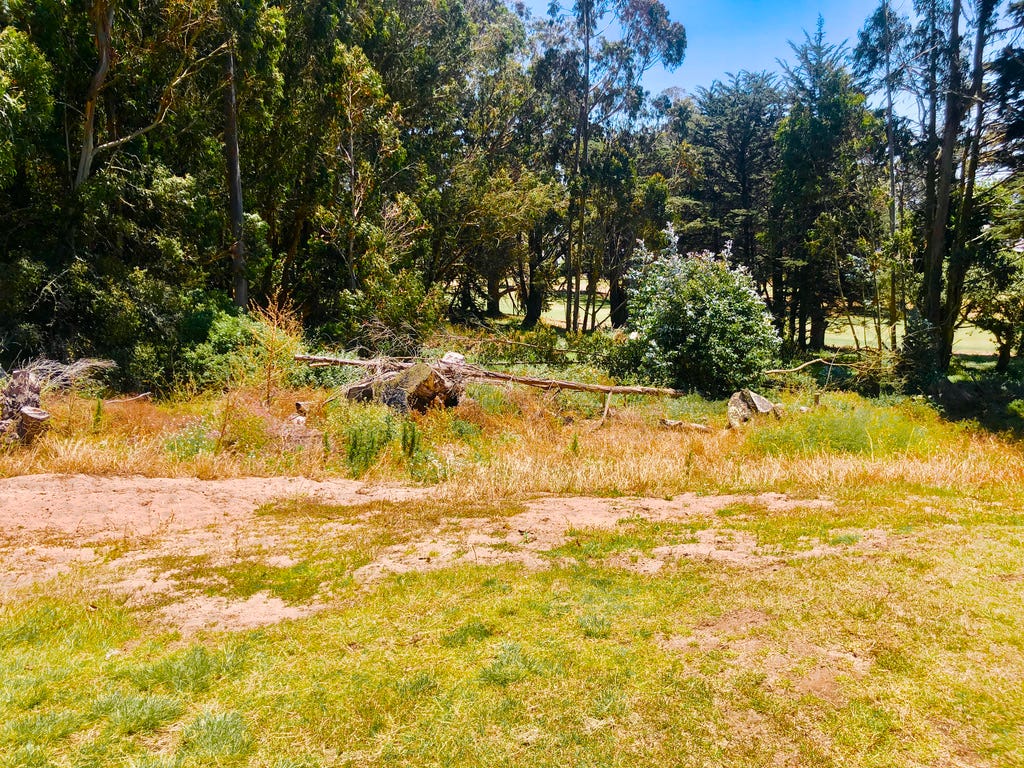This post is part of a series.1
Hole 8: par 3, 151 yards.
Hole 17: par 3, 171 yards.
This par three has a surprising number of options in terms of how to play the hole, but few ways to access the toughest pin positions. The green is way below the tees, about 40 feet downhill from tee to green. The most important feature is the steep slope of the green, which moves sharply to the right.
Send It High or Play It Low
The obvious approach is to play a high shot, try to stop it left of the hole location, and have it roll down, but that strategy carries risks. The biggest danger is ending up off the back, in the waste area. Everything about the tee shot increases this risk. The hole is about two clubs downhill and the prevailing wind can add another club or two as well.
Being in the waste area is a gamble. Players who roll off the back of the green will likely end up in a sandy playable area, no worse than a bunker, but those who fly the green may want to tee up a provisional. Lost balls are common behind the green. There are many mistakes players can make on this hole and still recover, but the worst is missing long-right. The back-right bunker is often a much better spot than down the hill behind it.
All this risk of overshooting the green has many players trying a different strategy: playing short to take the long miss out of play. Here, many club members play the hole as a makeshift reverse Redan hole.2 They will play a low, knockdown shot, short-left of the green and watch as it turns toward the green and moves across the green’s slope.
There is a hump in the landing zone exactly along the line of play that acts as a backstop, slowing the ball just as it reaches the green. When properly executed, this shot will allow the ball to trickle onto the green fairly consistently because it takes much of the wind and elevation out of play.
In the early morning the wind can be mild, however, the wind is usually high in the late morning or early afternoon when playing the back nine. Since the hole is longer on the back nine version, it’s not unusual for some to play the exact same club. The difference in wind speed can compensate for the entire space between front and back tees. The challenge here is often to play a much shorter shot than seems reasonable, whereas the Redan-style approach to this hole removes that concern.
Why Rollout (or Lack of Rollout) Matters
Pin positions on this hole dramatically change its difficulty. The aggressive slope of the hole means that any pins on the left side will be dramatically more difficult to get close to than hole locations at the bottom of the slope.
One frequent hole location (2) is on the right side, at the bottom of the main slope. Players who do not rollout past this hole location will be left with extremely challenging downhill putts. Often this means hitting a 90% shot with a bit more club, rather than a high shot designed to stop on a dime.
The toughest pin, however, is back-left (1), perched on the edge of the downslope. The green falls away slightly here, and this can lead to shots running off the back. Thanks to the rightward slope, any attempt to leave the ball by the hole means flirting with the left edge of the green. Any misjudged strike here creates serious risks of ending up in the waste area. To get to this location (1), players have a few choices. They can hit it high, spin it like crazy, and ride the wind while praying that it lands on the green and stops. Or, they could also play the knockdown to the left side of the kicker, slowing the ball down, and hoping that the two hops on the green are on the right line with the right speed. Most folks will just accept that the toughest position (1) is simply too challenging to attack, and just hit it to the center of the green and try to make the long putt.
The other two frequent positions allow for safer play. Short left (3) and right (4) allows players to bail out short of the green without too much trouble, as both hole locations are an easy up and down.
History
The vast majority of this hole has remained as it was created. The front-right and back-left bunkers are still there. The back-right bunker no longer prevents balls from running off the back slope, but it’s unclear whether this is enough to stop balls headed for disaster. The mostly pointless right-side bunker is not there, but it’s rarely in play these days anyway. Some trees seen in this historic photo are no longer present, but they do not play a major role on the hole anyway. This hole has been fairly effectively preserved.
Optionality Is Key to a Fun Par Three
When thinking about architecture on par threes, I typically find myself evaluating holes that ask players to make a challenging shot, and then reward and punish based on execution. It’s rare that par threes leave significant room for optionality. This hole shines in exactly that. A 151 yard shot that plays more like 130 yards should not be particularly challenging, yet the contours on the green give players pause when thinking about their club selection. It’s not very often that players might consider a running shot on a hole this short, but it’s often the best option here. The 171 yards on the back nine is certainly more challenging, but since it often plays closer to 140, we find an exaggerated version of the same hole, with much bigger tradeoffs for playing high vs playing low. Is it better to risk the wind pushing you over the back? Is it worse to misjudge the delicate runner and end up short of the green? It’s a par three that asks players to think hard not just about club selection, but whether a stock shot is even the best option at all. It’s something that makes a hole much more interesting than a standard par three. In the end, the hole isn’t a reverse Redan, but it shares the strategy of aiming away from the hole location itself for a surprisingly safe and effective approach.
Other posts in this series:
#1 & #10: A deep dive into the architecture that makes this intimidating opening hole so interesting.
#2 & #11: A Switch From Strategic to Penal Architecture
#3 & #12: Down the Hill
#4 & #13: Visible and Invisible
#5 & #14: Short and Long
#6 & #15: The Old Road
#7 & #16: Wind Tunnel and Blind Bunkers
#8 & #17: Invisible Redan
#9 & #18: Contours Forever
#19: Old Peculiar’s
The Redan template is modeled from the 15th hole at North Berwick. Here are some resources about this hole template:
b101 design: PGA Tour 2K21 Template Design: The Redan.
Fried Egg Golf: The Templates: The Redans of Macdonald, Raynor, and Banks.
Golf Magazine: What is a Redan hole, plus how identifying one can help your game.
Golf Digest: Course Design 101: Redan holes, explained.
Golf Digest: The 13 best Redan holes that you can actually play.










